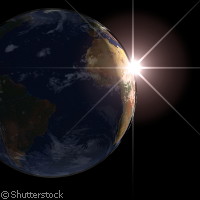Keeping Earth's technologies safe from space weather
Researchers worldwide are working to keep Earth's technologies safe from the threat of space weather. The latest researchers to join this effort are from the University of Leicester in the UK who have implemented a 'double pulse' radar-operating mode on two radars that are part of SuperDARN (Super Dual Auroral Radar Network), the international radar network for assessing the upper atmosphere and ionosphere of Earth. SuperDARN comprises 11 radars in the northern hemisphere and 7 in the southern hemisphere running in the High Frequency (HF) bands of between 8 and 22 megahertz (MHz). The radars allow observations of space weather that could wreak havoc on technologies on Earth. 'Intense space weather events are triggered by the explosive release of energy stored in the Sun's magnetic fields,' James D. Borderick of the Radio and Space Plasma Physics group at Leicester's Department of Physics and Astronomy said. 'A strong burst of electromagnetic energy reaches the Earth with the potential to disrupt many of our fundamental services, such as satellite and aviation operations, navigation, and electricity power grids.' Space weather could have adverse impacts on telecommunications and information technology, according to Mr Borderick. 'All modern societies rely heavily on space systems for communications and resource information (meteorological, navigation and remote sensing),' he said. 'There are high costs and high risks associated with the consequences of space weather events, as insurance companies recognise.' The researcher said the double pulse radar-operating mode was implemented on the group's Co-operative UK Twin Located Auroral Sounding System (CUTLASS) radars, which are located in Finland and Iceland. The CUTLASS system offers high time-resolution measurements of the ionospheric flow vectors. 'The new sounding mode enhances our temporal resolution of plasma irregularities within the ionosphere [the layer of the Earth's atmosphere that is ionised by solar radiation],' Mr Borderick explained. 'The resolution increase may help our understanding of coupling processes between the solar wind and the Earth's magnetosphere [highly magnetised region] by allowing the observation of smaller scale phenomena with an unprecedented resolution.' The researchers involved in this field of study are increasing their understanding of the phenomena associated with the Solar-Terrestrial interaction because they are using the new radar mode, as well as the ground-based and space-based instruments that are available, the Leicester researcher stated. Researchers will one day be able to make 'accurate predictions of intense weather events and an active defence', Mr Borderick further noted. This latest research highlights the significance of using ground-based measurements of the near space environment along with spacecraft observations. The results also draw attention to the direct influences of space weather on Earth's technological systems, according to the researcher.
Countries
United Kingdom



